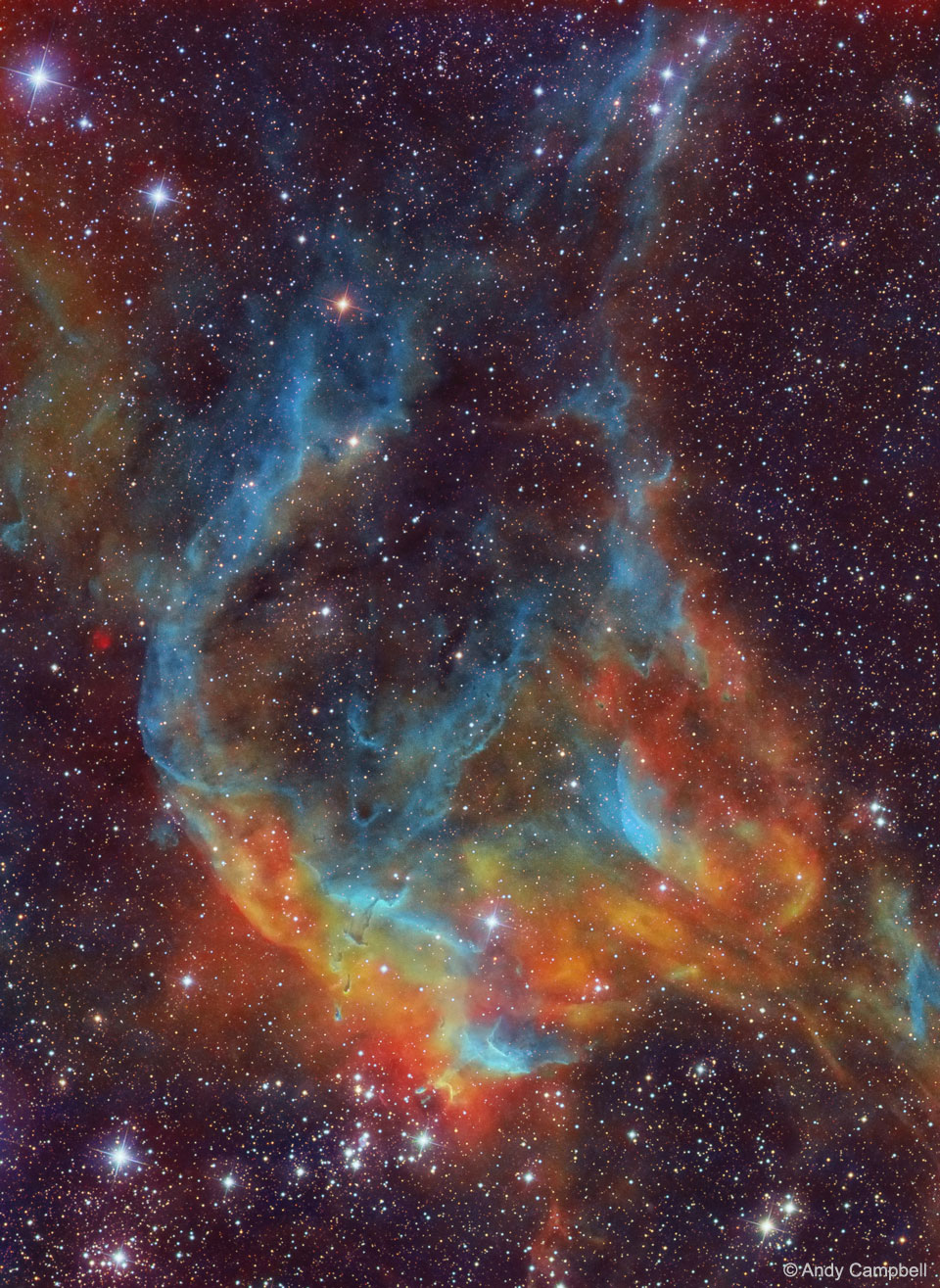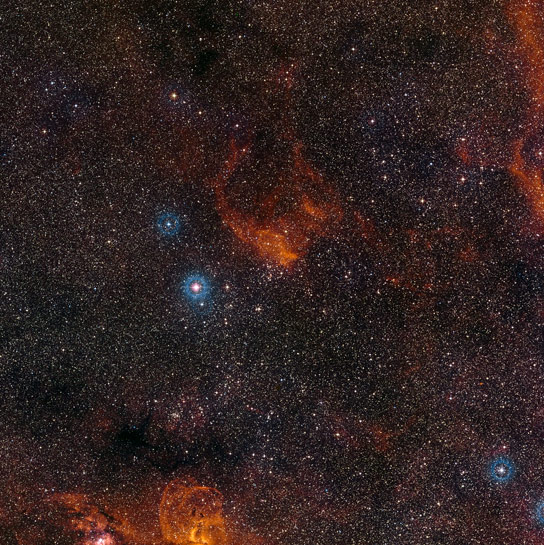Page 1 of 1
APOD: Stars, Dust, and Gas near NGC 3572 (2019 May 28)
Posted: Tue May 28, 2019 4:05 am
by APOD Robot
 Stars, Dust, and Gas near NGC 3572
Explanation:
Stars, Dust, and Gas near NGC 3572
Explanation: Star formation can be colorful.
This chromatic cosmic portrait features glowing gas and dark dust near some recently formed stars of
NGC 3572, a little-studied star cluster near the
Carina Nebula. Stars from NGC 3572 are visible near the bottom of the image, while the expansive gas cloud above is likely what remains of their formation nebula.
The image's striking hues were created by featuring specific colors emitted by hydrogen, oxygen, and sulfur, and
blending them with images recorded through broadband filters in red, green, and blue. This nebula near NGC 3572 spans about 100
light years and lies about 9,000 light years away
toward the southern constellation of the Ship's Keel (
Carina). Within a few million years the pictured gas will likely disperse, while
gravitational encounters will likely disperse the cluster stars over about a billion years.
Re: APOD: Stars, Dust, and Gas near NGC 3572 (2019 May 28)
Posted: Tue May 28, 2019 4:57 am
by ecw3
The Tulip Nebula.
Re: APOD: Stars, Dust, and Gas near NGC 3572 (2019 May 28)
Posted: Tue May 28, 2019 9:41 am
by starsurfer
The large nebula is catalogued as Gum 37.
Re: APOD: Stars, Dust, and Gas near NGC 3572 (2019 May 28)
Posted: Tue May 28, 2019 11:36 am
by orin stepanek
Re: APOD: Stars, Dust, and Gas near NGC 3572 (2019 May 28)
Posted: Tue May 28, 2019 12:39 pm
by AVAO
What a great composite picture!
But what is the blue oval-shaped ring in the left upper half of the picture? Hydrogen, oxygen, or sulfur?
Re: APOD: Stars, Dust, and Gas near NGC 3572 (2019 May 28)
Posted: Tue May 28, 2019 6:11 pm
by HellCat
Absolutely stunning. Maybe it's just me, but when rotated 180 degrees the image is more attractive.
Re: APOD: Stars, Dust, and Gas near NGC 3572 (2019 May 28)
Posted: Tue May 28, 2019 10:10 pm
by Boomer12k
Awesome colors...
"The Fat Spaceman Nebula"... when I clicked on the image the full size picture looked like a Fat Spaceman with a ray-gun raised in his right hand....
:---[===] *
Re: APOD: Stars, Dust, and Gas near NGC 3572 (2019 May 28)
Posted: Tue May 28, 2019 10:15 pm
by Boomer12k
AVAO wrote: ↑Tue May 28, 2019 12:39 pm
What a great composite picture!
But what is the blue oval-shaped ring in the left upper half of the picture? Hydrogen, oxygen, or sulfur?
Generally Blue... is Oxygen in this type image...Sulfur is Yellow, and Hydrogen is Red...
I don't know if that changes with the Broadband RGB blended though...
:---[===] *
Re: APOD: Stars, Dust, and Gas near NGC 3572 (2019 May 28)
Posted: Tue May 28, 2019 11:08 pm
by Ann
Boomer12k wrote: ↑Tue May 28, 2019 10:15 pm
AVAO wrote: ↑Tue May 28, 2019 12:39 pm
What a great composite picture!
But what is the blue oval-shaped ring in the left upper half of the picture? Hydrogen, oxygen, or sulfur?
Generally Blue... is Oxygen in this type image...Sulfur is Yellow, and Hydrogen is Red...
I don't know if that changes with the Broadband RGB blended though...
:---[===] *
NGC 3572. Image Credit & Copyright: Andrew Campbell.
NGC 3572. Image credit: ESO/Digitized Sky Survey 2.
Indeed, oxygen is normally blue in images like these. Hydrogen is normally green and sulphur is normally red.
In today's APOD, it seems to me that the blue parts of the nebula are "too thick" to be oxygen. The "main nebular strands" of the nebula are blue in the APOD, and normally these features would be dominated by hydrogen (and some sulphur).
Think of a nebula as a vase. I believe that the "walls" of the nebula, the "vase" of it, would be hydrogen. Inside the "vase", inside the "nebular walls", there would be oxygen. What about sulphur? Oh... ask someone who gets a kick out of red things!

That's why I'm guessing that "the walls of nebula NGC 3572" must be hydrogen, and that hydrogen, therefore, might be blue in this APOD.
Compare the APOD with the ESO/Digitized Sky Survey 2 image, where hydrogen is certainly red, and you can see that the brightest features of the nebula in that picture are for the most part the ones that look blue in the APOD.
Ann
Re: APOD: Stars, Dust, and Gas near NGC 3572 (2019 May 28)
Posted: Thu May 30, 2019 8:44 am
by AVAO
Ann wrote: ↑Tue May 28, 2019 11:08 pm
Boomer12k wrote: ↑Tue May 28, 2019 10:15 pm
AVAO wrote: ↑Tue May 28, 2019 12:39 pm
What a great composite picture!
But what is the blue oval-shaped ring in the left upper half of the picture? Hydrogen, oxygen, or sulfur?
Generally Blue... is Oxygen in this type image...Sulfur is Yellow, and Hydrogen is Red...
I don't know if that changes with the Broadband RGB blended though...
:---[===] *
NGC 3572. Image Credit & Copyright: Andrew Campbell.
NGC 3572. Image credit: ESO/Digitized Sky Survey 2.
Indeed, oxygen is normally blue in images like these. Hydrogen is normally green and sulphur is normally red.
In today's APOD, it seems to me that the blue parts of the nebula are "too thick" to be oxygen. The "main nebular strands" of the nebula are blue in the APOD, and normally these features would be dominated by hydrogen (and some sulphur).
Think of a nebula as a vase. I believe that the "walls" of the nebula, the "vase" of it, would be hydrogen. Inside the "vase", inside the "nebular walls", there would be oxygen. What about sulphur? Oh... ask someone who gets a kick out of red things!

That's why I'm guessing that "the walls of nebula NGC 3572" must be hydrogen, and that hydrogen, therefore, might be blue in this APOD.
Compare the APOD with the ESO/Digitized Sky Survey 2 image, where hydrogen is certainly red, and you can see that the brightest features of the nebula in that picture are for the most part the ones that look blue in the APOD.
Ann
Thank you both! These are very helpful information.
Re: APOD: Stars, Dust, and Gas near NGC 3572 (2019 May 28)
Posted: Fri May 31, 2019 1:17 pm
by Andy 01
Hey team,
Just to answer the question about how I colour mapped this image, Ha>Blue, O3>Red, S2> Green.
Not the usual HST palette but this time it worked for me on this image.
Thanks for your feedback, cheer from Downunder

Andy
 Stars, Dust, and Gas near NGC 3572
Stars, Dust, and Gas near NGC 3572

